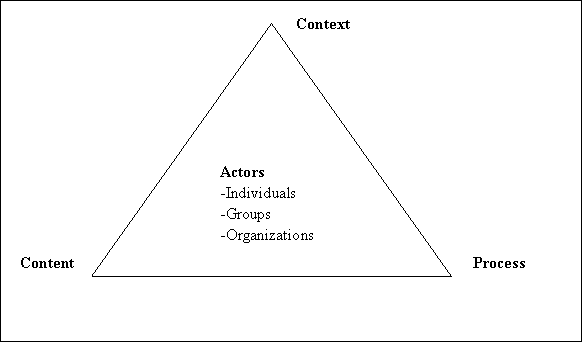Equality, Equity and Policy: Principal Approaches to Policy Formation
Health policies are formed through the complex inter-relationship of context, process and actors. Walt and Gibson (1994 in Buse et al, 2005) have proposed the health policy triangle as a way of systematically thinking about all the different factors that may affect policy (Figure 1).
Figure 1: The Health Policy Triangle

Source Walt and Gilson, 1994 (in Buse et al, 2005)
Actors refer to individuals, organisations or the state, and their actions that affect health policy. All actors have their own interests and agendas. Examples of actors include individuals, international NGOs, national NGOs, pressure/interest groups, international organisations, bilateral agencies, funding organisations, private sector companies, and the media.
Context means systematic factors - political, economic, social or cultural, both national and international - which may have an effect of health policy. These include:
- Situational factors- transient, impermanent conditions which can have an impact on policy (e.g. wars, droughts)
- Structural factors- relatively unchanging elements of society (e.g. the political system, type of economy, demographic features)
- Cultural factors- religion, ethnicity, genderInternational or exogenous factors- some policies require cooperation between national, regional or multilateral organisations
Content is the substance of a particular policy which details the subjects and topics covered.
Process is the way in which policies are initiated, developed or formulated, negotiated, communicated, implemented and evaluated.
Policy formation falls into the process corner of the framework above and is influenced by actors, content, and context. Sometimes the process is rational - systematically weighing the pros and cons of various alternatives; and sometimes the process is incremental - an iterative decision making process (Buse et al., 2005)
Whilst it can be helpful to assess policy formation as a rational, staged process (problem identification, followed by policy formulation, implementation and evaluation), in practice these stages rarely follow in a linear fashion. (Katikirredi et al, 2014; Buse et al, 2005)
Alternative theories of policy formation include
- Kingdon’s multiple-streams theory. Three ‘streams’ must converge for policy to come about: problem, policy and politics. Streams may be brought together by advocates known as ‘policy entrepreneurs’.
- Punctuated-Equilibrium theory. Periods of policy ‘equilibrium’ in which policy remains unchanged are punctuated by rapid policy transformation.
Box 1: Case study – the process of introducing alcohol minimum unit pricing (MUP) in Scotland
|
In 2007, following the election of the minority Scottish National Party (SNP) the Scottish Health Action on Alcohol Problems (SHAAP) convened an expert group to investigate the relationship between the price of alcohol and alcohol-related harm. The group reported that the affordability of alcohol was playing a large part in increases in alcohol-related harm in Scotland and recommended implementing floor-pricing mechanisms. At the same time a team in Sheffield used econometric modelling to compare the effects of implementing different alcohol pricing interventions and concluded that minimum unit pricing (MUP) would have the greatest impact on individuals who were at highest risk of alcohol-related harm. A discussion paer was published by the Scottish government in June 2008 consulting on MUP along with other alchol pricing interventions; the paper was widely read and sparked debate within Parliament and the media. In spite of the evidence in support of minimum unit pricing the first attempt to introduce it in the Scottish Parliament was unsuccessful, with only the SNP in support of the Bill. In May 2011 the SNP, who had included MUP in their manifesto, won a majority of seats in Scottish Parliament. The Scottish government passed the Alcohol (Minimum Pricing) (Scotland) Act in June 2012, however the Act has yet to become legislation due to legal challenges from the alcohol industry. Applying the multiple-streams theory of policy analysis to this case study, the 'problem' stream stemmed from the (previously undocumented) epidemiological association between alchol pricing and alcohol-related harm. The 'solutions' stream was put on course by the SHAAP paper which recommended floor-pricing mechanisms, and the 'politics' stream was diverted by the election of the Scottish National Party who supported MUP. The policy came about when all three streams met and converged. (Katikireddi et al, 2014) |
References
- Anderson g, Sotir Hussey P (2006). Influencing government policy. In: Pencheon D, Guest C, Melzer D, Muir Gray JA (eds) Oxford Handbook of Public Health. Oxford University Press.
- Buse K, Mays N, Walt G (2005). Making Health Policy. Understanding Public Health Series Open University Press.
- Katikireddi SV, Hilton S, Bonell C, Bond L. (2014) Understanding the Development of Minimum Unit Pricing of Alcohol in Scotland: A Qualitative Study of the Policy Process. PLoS One. 9(3): e91185.
- Walt G, Gibson L (1994). “Reforming the health sector in developing countries: The central role of policy analysis”. Health Policy and Planning, 9: 353-70.
© Rebecca Steinbach 2009, Rachel Kwiatkowska 2016
